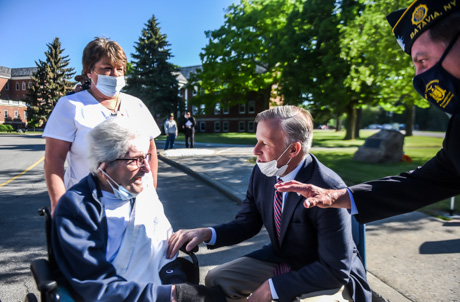People on both sides of the solar fence – farmers who have signed on to lease their land and labor union representatives who are for it and longtime residents who are against it – expressed their views this afternoon at a public statement hearing on the application of Excelsior Energy Center LLC to construct the 280-megawatt, 1,600-acre Excelsior Energy Center in the Town of Byron.
The one-hour hearing took place via www.webex.com, with the audio livestreamed on YouTube.
A second hearing is scheduled for 6 o’clock tonight. Information needed to access the session can be found at the end of this story.
Administrative Law Judges Gregg Sayre of the Department of Public Service and Molly McBride of the Department of Environmental Conservation presided over the hearing, which allowed for brief statements (longer statements could be submitted via email or mail) but no question-and-answer period.
Sayre said that all comments in all forms will be considered by the New York State Board on Electric Generation Siting and the Environment (siting board) as it decides whether to allow the project to go forward.
The Byron Town Board already has indicated its support for the project, emphasizing that Excelsior Energy has committed to payments totaling $24 million to the municipality over a 20-year period.
A citizen-led organization known as Byron Association Against Solar, which includes Town Councilman Eric Zuber, has been outspoken in its opposition of the venture – citing disruption of the rural character of the community and the use of prime farmland.
The project also includes a 20-megawatt, four-hour duration energy storage system. Components would consist of solar arrays, access roads, buried and possibly overhead electric collection lines, energy storage and electrical interconnection facilities.
According to the siting board filing, additional facilities would consist of a new collection substation and 345-kilovolt switchyard, which would connect to the New York State grid and would be transferred to the New York Power Authority to own, maintain and operate.
Participating local landowners include Legacy Lands LLC; Brooke-Lea LLC; Call Lands; Lea-View Farms LLC; Richard Colby; L-Brooke Farms LLC; John Starowitz; Leo Starowitz Jr.; Star Growers Land LLC; John Starowitz and Andrew Starowitz; John Sackett Jr. and Charles Sackett; CY Properties LLC; and Call Lands Partnership.
Following is a summary of today’s public statement hearing:
Debra Buck-Leaton
Byron Town Clerk and owner of Lea-View Farms Inc.
Buck-Leaton contended that the solar project will provide many advantages to “our farming business and the community.”
She said that her family farm has been in operation since 1929, being passed down through three generations, and “has always prided ourselves in being good stewards of our land – preserving it for future generations.”
She said increased costs of farming are overwhelming and have led to insecurity.
“Many people have said that we are giving up prime farmland. Everyone needs to keep in mind that prime farmland is and can only be considered prime farmland if it is able to be farmed. If we can’t afford to farm the land, it can only be considered vacant land.”
She noted that revenue from NextEra (Excelsior Energy) will enable her family to make needed repairs to their buildings and equipment, and will enable the Town of Byron to “afford things that we never could have imagined.”
“With good leadership, the town will be able to be good stewards of our small town well into the future,” she said, adding that the local farmers involved with Excelsior Energy are committed to staying in the town and helping the community in the future.
James Vincent
Retired president/CEO of L-Brooke Farms and associated companies
Vincent said L-Brooke Farms has grown from 500 acres to 7,500 acres in his 55 years, covering land in six counties.
He said the company is an advocate “of green energy, integrated technology and the many advantages that the Excelsior Solar Project represents – not just because of having some of our lands involved in the solar leases, but what a dynamic and steady income stream means to our farm business model.”
He called these times as “unprecedented and challenging” for farmers, the town, school district and Genesee County” and for the economy and rural lifestyle.
Vincent said his operation pays more than $200,000 a year in local and school taxes … “but basing it on real estate taxation puts us in an unfavorable competitive position.”
“The community will benefit from this project, providing benefits that translate into less tax burden to agriculture -- the host benefit packages and the PILOT* agreement that are incorporated in it,” he said. “The importance of having solar for agriculture and associated services furthers our history of success in having diversity for our farm business.”
He said that “alternative sources of income are absolutely essential if our farm businesses and the associated land base are to be sustained and provide opportunity for future generations.”
Vincent Albanese
New York State Laborers’ International Union of North America
Speaking on behalf of 40,000 men and women in New York who are members of the affiliated local union of LIUNA, Albanese said the union “would like to strongly encourage the swift approval of the Excelsior Solar Project as it pertains to these Article 10 (state law) proceedings.”
He said the union’s interest is two-fold – (1) the well-being of its members and ensuring that any project has a commitment to using local union workers and (2) that any project pertaining to the replacement of traditional fossil fuel jobs is being built in New York with New York local union workforce.
Albanese said NextEra has committed to using local union workers.
Barbie Starowitz
Star Growers
Starowitz, a longtime Byron resident, said that since 1932, her family has always wished to grow and maintain the land for generations to come.
“Excelsior Energy Center will not only support our farm for future generations … but will also provide new local revenue, new local jobs for our community and continue to provide us with the opportunity to support other farmers in our area,” she said. “Farm communities are stronger when we work together and we will continue to support activities pursued by others in our community, on our land.”
Starowitz said that Excelsior Energy Center will pump $37.4 million to the town, Byron-Bergen Central School District and Genesee County, and create 290 full-time equivalent jobs during construction, with 90 percent of those local workers.
She said diversification is essential to the survival of farmers, who depend on the weather to yield strong crops. She said that solar will provide a steady stream of income while not removing the land from potential future agricultural use.
Starowitz also commended Excelsior Energy Center for being available to the community throughout the process to provide “valuable information” and to answer questions. She said the entire Byron community of 2,300 people will benefit from the project.
Richard Colby
Landowner
Colby, who said as a young man he worked the land that has been offered for the project, emphasized the changing use of land and decrease in crop variety over years, especially in the Town of Byron.
“One thing that the solar will bring is jobs – well-paying jobs and added value to the community,” he said.
As far as the downside, Colby said it’s just the opposite as the land won’t produce noxious smells, won’t create a lot of traffic, won’t use chemicals or rely on fossil fuels, isn’t illegal, and won’t lower the real estate values.
On the contrary, he sees home values increasing as more money comes into the community.
Colby said only about half of his property will be covered by solar panels, and he is looking for other ways to diversify crops on the remaining land.
He said he sees the solar project as a complementary land use, not as a negative use.
Carmen Serrett Jr.
President of Laborers’ Union Local #435, Rochester
Representing about 600 working members, Serrett said union employees have been hampered over the last year due to COVID-19 and looks forward to high-paying projects such.
“It’s very important that local people are working on these projects as they earn their money, they spend money locally and are boosting each local economy,” he said, adding that he would like to see it move forward as quickly as possible.
Michael Bader
Business Manager, International Brotherhood of Electrical Workers Local Union #86
Bader said he represents 1,000 electricians, some of them in Genesee County, who support the project as it helps the state meet its clean energy goals and will create “good-paying careers for my members and other members of the local building trades.”
He also said it will create job-training opportunities for apprenticeships and, after construction, some long-term jobs for local people, such as mowing, plowing and maintenance.
Richard Glazier
Longtime Byron resident
Glazier said he is opposed as the panels would be placed on “mostly class one farmland, some of the best land in New York State.”
He said that droughts have pushed prices for corn and soybeans much higher, emphasizing the need to preserve good farmland.
Glazier suggested placing the panels on less valuable land, offering that renewable energy sources aren’t as desirable “as an adequate and affordable food supply.”
The panels also will cause “visual pollution” in the community, he said, and the size of the project in the small town will have a negative impact on the quality of life in the Town of Byron.
“It will never quite be the same,” he said.
He said he couldn’t fault the landowners for accepting Excelsior Energy’s offer. However, he said the Town Board is “enamored with the size of the payment in lieu of taxes” and said these projects are only available because they’re already being subsidized by the taxpayers of New York State.
Glazier also spoke about toxic chemicals in the panels and said that public sessions over the past months via Zoom were not adequate in providing information to all town residents; many of them who do not have internet access.
Jim Lamkin
Longtime Byron resident, BAAS representative
A 70-year resident of Byron, Lamkin has spoken out against the project “going on some of the best prime farmland in New York State” from the beginning.
He called BAAS a grassroots organization of longtime residents and business owners formed to prevent or limit the size of the Excelsior Energy solar system.
“We are not against solar energy but we are concerned that the placement of the solar panels is very close to residences and we are further concerned with the use of prime farmland,” he said.
Lamkin also said BAAS is “concerned that the solar project will disrupt the current and future productivity of the land, lower surrounding home and land values, will be an intrusive eyesore for the residents, and will have targeted and ripple effects in the surrounding agriculture-based economy.”
He mentioned that in December 2019, a survey was sent to about 900 Byron residents and 350 of them came back opposing the project.
He also said the applicant has failed to produce a plan that shows adequate screening of the solar arrays from residents’ views and is concerned about the potential long-term contamination of the soil.
Finally, Lamkin said the project is in “direct conflict” with the Town of Byron’s Comprehensive Plan that states that “maintaining the rural character is the most crucial factor,” along with preserving the agricultural base land and farms.
PUBLIC HEARING TONIGHT AT 6'OCLOCK
Electronic Access: www.webex.com;
Event Number: 129 881 6364
Password: June 1-6 p.m.
Phone-Only Access: (518) 549-0500
Access Code: 129 881 6364
OTHER WAYS TO COMMENT
All comments must refer to Case: 19-F-0299
Email: secretary@dps.ny.gov
Mail: Hon. Michelle L. Phillips, Secretary, NYS Board on Electric Generation Siting and the Environment. Three Empire State Plaza, Albany, NY 12223-1350
Phone: 1-800-335-2120
Electronic: www.dps.ny.gov - Click on "Search" at the top of the page; then enter 19-F-0299 into the "Search by Case Number" field; click on the "Post Comments" box at the top right of the page, enter comments and submit.
*Payment In Lieu Of Taxes






























